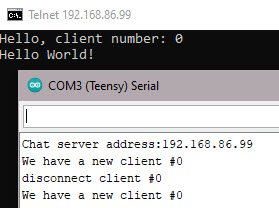T41 noob here (but have used the T40).
I'm trying to get two T41's to talk to each other over Ethernet using the NativeEthernet + FNET ZIP libs from Github. Both T41s are equipped with the PJRC magjack kit.
I've started at square 1 with the Advanced Chat Server Example, trying to get just *one* T41 talking to a Telnet window on my Win10 box.
I only changed the IP addresses to fit my network in the example code, but it's pasted below for the sake of completion.
I can connect to the T41 via Telnet.
T41 confirms the client connection
"Hello, client number: 0" shows up in my Windows Telnet session
....but that's it. Any further input into my telnet box results in *nothing* on the other (T41) end.
If I close the Telnet window, the T41 reports "disconnect client #0"
I'm guessing this is just some stupid mistake/misunderstanding on my part. Any know what it is?

Thanks all. This looks like a great library and hardware. Looking forward to getting past Step 1.
I'm trying to get two T41's to talk to each other over Ethernet using the NativeEthernet + FNET ZIP libs from Github. Both T41s are equipped with the PJRC magjack kit.
I've started at square 1 with the Advanced Chat Server Example, trying to get just *one* T41 talking to a Telnet window on my Win10 box.
I only changed the IP addresses to fit my network in the example code, but it's pasted below for the sake of completion.
I can connect to the T41 via Telnet.
T41 confirms the client connection
"Hello, client number: 0" shows up in my Windows Telnet session
....but that's it. Any further input into my telnet box results in *nothing* on the other (T41) end.
If I close the Telnet window, the T41 reports "disconnect client #0"
I'm guessing this is just some stupid mistake/misunderstanding on my part. Any know what it is?

Code:
/*
Advanced Chat Server
A more advanced server that distributes any incoming messages
to all connected clients but the client the message comes from.
To use, telnet to your device's IP address and type.
You can see the client's input in the serial monitor as well.
Using an Arduino Wiznet Ethernet shield.
Circuit:
* Ethernet shield attached to pins 10, 11, 12, 13
created 18 Dec 2009
by David A. Mellis
modified 9 Apr 2012
by Tom Igoe
redesigned to make use of operator== 25 Nov 2013
by Norbert Truchsess
*/
#include <SPI.h>
#include <NativeEthernet.h>
// Enter a MAC address and IP address for your controller below.
// The IP address will be dependent on your local network.
// gateway and subnet are optional:
byte mac[] = {
0x04, 0xE9, 0xE5, 0x0D, 0x62, 0x08
};
IPAddress ip(192, 168, 86, 99);
IPAddress myDns(192, 168, 86, 1);
IPAddress gateway(192, 168, 86, 1);
IPAddress subnet(255, 255, 0, 0);
// telnet defaults to port 23
EthernetServer server(23);
EthernetClient clients[8];
void setup() {
// initialize the Ethernet device
Ethernet.begin(mac, ip, myDns, gateway, subnet);
// Open serial communications and wait for port to open:
Serial.begin(9600);
while (!Serial) {
; // wait for serial port to connect. Needed for native USB port only
}
// Check for Ethernet hardware present
if (Ethernet.hardwareStatus() == EthernetNoHardware) {
Serial.println("Ethernet shield was not found. Sorry, can't run without hardware. :(");
while (true) {
delay(1); // do nothing, no point running without Ethernet hardware
}
}
if (Ethernet.linkStatus() == LinkOFF) {
Serial.println("Ethernet cable is not connected.");
}
// start listening for clients
server.begin();
Serial.print("Chat server address:");
Serial.println(Ethernet.localIP());
}
void loop() {
// check for any new client connecting, and say hello (before any incoming data)
EthernetClient newClient = server.accept();
if (newClient) {
for (byte i=0; i < 8; i++) {
if (!clients[i]) {
Serial.print("We have a new client #");
Serial.println(i);
newClient.print("Hello, client number: ");
newClient.println(i);
// Once we "accept", the client is no longer tracked by EthernetServer
// so we must store it into our list of clients
clients[i] = newClient;
break;
}
}
}
// check for incoming data from all clients
for (byte i=0; i < 8; i++) {
if (clients[i] && clients[i].available() > 0) {
// read bytes from a client
byte buffer[80];
int count = clients[i].read(buffer, 80);
// write the bytes to all other connected clients
for (byte j=0; j < 8; j++) {
if (j != i && clients[j].connected()) {
clients[j].write(buffer, count);
}
}
}
}
// stop any clients which disconnect
for (byte i=0; i < 8; i++) {
if (clients[i] && !clients[i].connected()) {
Serial.print("disconnect client #");
Serial.println(i);
clients[i].stop();
}
}
}Thanks all. This looks like a great library and hardware. Looking forward to getting past Step 1.

